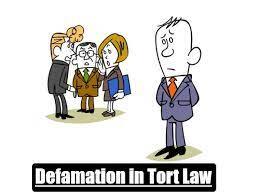Radhika Mittal, a 1st-year student of the Faculty of Law, Delhi University has written this article explaining Defamation in tort law.
Introduction
Defamation is a legal term that refers to any statement that harms someone’s reputation. It can be in the form of spoken or written words, pictures, or gestures that are conveyed to others and cause injury to the reputation of the person targeted. In legal terms, it is an actionable tort, which means that a person can file a lawsuit against the defendant for making defamatory statements. In this article, we will explore the elements that have shaped the legal landscape around defamation in tort law. We will also discuss some of the landmark case laws.
Defamation is a common law tort that has its roots in English law. The tort of defamation involves the making of a false statement that injures a person’s reputation. In this section, we will explore the history of defamation and how it has evolved over time. In order to establish a claim of defamation, the plaintiff must prove that the defendant made a false statement that caused harm to the plaintiff’s reputation. The statement must also have been published to at least one other person. In most jurisdictions, the plaintiff must also prove that the defendant acted with negligence or malice when making the statement.
Two forms of Defamation
Defamation can take two forms: libel and slander. Libel refers to a written or published statement that is defamatory, while slander refers to an oral defamatory statement. In many jurisdictions, the rules for proving libel and slander are the same, but there may be some differences in the way that the law treats these two forms of defamation.
The harm caused by defamation can be significant. It can affect a person’s personal and professional reputation, as well as their relationships and opportunities. Defamation can be particularly damaging when it is spread widely, such as through social media or mass media outlets.
In order to defend against a claim of defamation, the defendant may argue that the statement was true, or that it was made in the public interest. In some cases, defendants may also be able to argue that the statement was a fair comment or privileged communication, which means that it was made in the course of fulfilling a legal or social duty, such as in a court proceeding or a news report.
History of Defamation
The origins of defamation traced back to ancient Rome, where it was considered a crime to speak ill of someone. Roman law recognized two forms of defamation: “slander,” which was the spoken form of defamation, and “libel,” which was the written form of defamation. In England, the common law tort of defamation emerged in the 17th century. The first reported case of defamation in English law was in 1603, when Sir Edward Coke, an English barrister, and jurist, successfully sued a man for accusing him of bribery. In the 17th and 18th centuries, defamation law in England was heavily influenced by the Star Chamber, a court established by King Henry VIII to deal with cases of defamation and other offenses against the crown.
In the early 19th century, the English courts began to recognize the importance of freedom of speech and the press. The case of Burdett v. Abbot, in 1817 established the principle that comments made in the House of Commons were immune from prosecution for defamation. This principle was later extended to cover comments made in newspapers and other public forums.
Development of Defamation Law in the United States
Defamation law in the United States is based on English common law, but it has developed in a unique way. In the early days of the United States, defamation law was heavily influenced by the Sedition Act of 1798, which made it a crime to criticize the government. However, in the landmark case of New York Times Co. v. Sullivan (1964), the Supreme Court held that the First Amendment protected speech that criticized public officials, even if the speech contained false statements.
In the 20th century, defamation law in the United States became more focused on protecting individuals from false and harmful statements made by others. The development of new technologies, such as radio, television, and the internet, has created new challenges for defamation law, but the basic principles remain the same.
Elements of Defamation
To establish a claim of defamation in a court of law, the plaintiff must prove the following elements:
Publication
The defamatory statement must have been published by a third party. This means that the statement must have been communicated to someone other than the plaintiff.
Falsity
The statement must be false. If the statement is true, then it cannot be considered defamatory.
Harm
The statement must have caused harm to the plaintiff’s reputation. This harm can also be in the form of damage to the plaintiff’s business, loss of income, or harm to their personal reputation.
Fault
The plaintiff must establish that the defendant was at fault for making the defamatory statement. This fault can be established either by showing that the defendant knew the statement was false or that the defendant was negligent in making the statement.
Defamation under Tort
Defamation in tort law exists in various forms and under different legal systems around the world. Some examples of how defamation is treated under the laws of different countries are:
United States
Defamation law in the United States is based on common law principles and the First Amendment to the Constitution, which protects freedom of speech and the press. In order to establish a claim of defamation, a plaintiff must prove that the defendant made a false statement of fact that harmed the plaintiff’s reputation. The plaintiff must also show that the statement was made with negligence or malice.
United Kingdom
Defamation law in the UK is also based on common law principles. In order to establish a claim of defamation, a plaintiff must prove that the defendant made a false statement that caused harm to the plaintiff’s reputation. The statement must also have been published to at least one other person. Unlike USA, in UK, the burden of proof is on the defendant to prove that the statement was true.
Canada
Defamation law in Canada is also similar to that in the UK. In Canada also the burden of proof lies on the plaintiff. In addition, the statement must have been published to at least one other person. The burden of proof is on the plaintiff to prove that the statement was false. If the plaintiff can establish that the statement was defamatory, the defendant must prove that it was true or made in good faith.
Australia
Defamation law in Australia is governed by state and territory legislation, but it is largely based on English common law. In order to establish a claim of defamation, a plaintiff must prove that the defendant made a false statement that harmed the plaintiff’s reputation. The statement must also have been published to at least one other person. Unlike in the UK, the burden of proof is on the plaintiff to prove that the statement was false.
India
Defamation law in India is based on English common law principles. Whereas, in order to establish a claim of defamation, a plaintiff must prove that the defendant made a false statement that harmed the plaintiff’s reputation. The statement must also be published to at least one other person. Moreover, The burden of proof is on the plaintiff to prove that the statement was false.
Landmark Cases
New York Times Co. v. Sullivan (1964)
This case involved an advertisement in the New York Times that criticized the Montgomery, Alabama police department for its treatment of civil rights activists. The advertisement contained several minor factual errors, and the police commissioner sued the New York Times for defamation. In this case, the Supreme Court ruled that for public officials to recover damages for defamation, they must prove that the statement was made with actual malice. This means the statement was made with knowledge of its falsity or with reckless disregard for the truth.
Hustler Magazine v. Falwell (1988)
This case involved a parody advertisement in Hustler Magazine that suggested that the Reverend Jerry Falwell had an incestuous relationship with his mother. Falwell sued Hustler for defamation, but the Supreme Court held that the First Amendment protected speech that was outrageous or offensive, even if it was intended to be taken seriously. In addition, the court also held that public figures, like Falwell, to show actual malice to recover damages for defamation.
Milkovich v. Lorain Journal Co. (1990)
In this case, the newspaper columnist accused a high school wrestling coach of lying under oath. The coach filed a defamation lawsuit against the newspaper, but the Supreme Court ruled that the First Amendment protects opinions, even if they are false and harmful. Moreover, the court also ruled that if an opinion implies a statement of fact that can be proven false, then the statement may be considered defamatory.
McLibel case (1997)
This case involved a defamation suit of tort law brought by McDonald’s Corporation against two environmental activists, Helen Steel, and Dave Morris. The defendants had distributed a leaflet critical of McDonald’s practices, and the company sued for libel. The case lasted over ten years and became the longest trial in English history. The defendants ultimately won the case, with the court finding that many of the criticisms in the leaflet were justified.
Derbyshire County Council v. Times Newspapers Ltd. (1993)
This case involved an article in The Times newspaper that accused the council of improperly removing children from their families. The council sued for libel, and the case went to trial. The court ultimately found in favor of the newspaper, holding that the article was true and in the public interest.
Reynolds v. Times Newspapers Ltd. (2001)
This case established the “Reynolds defense,” which allows journalists to publish defamatory material if they can demonstrate that it was in the public interest to do so. The case involved an article in The Sunday Times newspaper that accused the Irish politician Albert Reynolds of being involved in the cover-up of a criminal investigation. Reynolds sued for libel, but the court found that the article was protected by the Reynolds defense.
Jameel v. Wall Street Journal Europe (2006)
This case involved an article in the Wall Street Journal that accused a Saudi Arabian businessman, Khalid bin Mahfouz, of financing terrorism. Mahfouz sued for libel, but the court found that the article was protected by qualified privilege, which allows the publication of defamatory material in certain circumstances, such as where there is a duty to report on a matter of public interest.
Flood v. Times Newspapers Ltd. (2011):
Denis MacShane sued The Times newspaper for libel over an article that accused him of false expense claims as MP. The court found the article was protected by the defense of responsible journalism, which allows defamatory material if it’s accurate and reasonable steps taken
Landmark Indian Cases Related to Defamation.
There have been several landmark cases in India related to the tort of defamation. Some of the most notable ones are:
Ram Jethmalani v. Subramanian Swamy (2006)
This case involved a defamation suit filed by Ram Jethmalani, a senior advocate, against Subramanian Swamy, a politician, for making defamatory statements against him. The Delhi High Court awarded damages of Rs. 25 lakhs to Jethmalani, stating that Swamy had not been able to prove the truth of his allegations.
Priya Ramani v. MJ Akbar (2019)
MJ Akbar, a former Union Minister, filed a defamation suit against journalist Priya Ramani for accusing him of sexual harassment. The Delhi High Court dismissed Akbar’s suit. The court stated that Ramani’s allegations were protected by free speech and made in the public interest.
Sahara India Real Estate Corporation Ltd.
Sahara India Real Estate Corporation filed a defamation suit against the Securities and Exchange Board of India (SEBI) for defamatory statements. The Supreme Court dismissed Sahara’s suit, stating that SEBI acted in the public interest and made no false statements.
Balraj Kishore v. State of U.P.
This case involved a defamation suit filed by Balraj Kishore, a Hindi author, against the state of Uttar Pradesh for banning his book, “Azadi Ke Bad.” The Supreme Court dismissed Kishore’s suit, stating that the state had the power to ban a book if it was likely to cause public disorder or offend public morality.
Tata Sons Ltd. v. Greenpeace International
Tata Sons Ltd. filed a defamation suit against Greenpeace International and others over defamatory statements related to a power plant’s construction. The Delhi High Court dismissed Tata’s suit. The court held that Greenpeace’s statements were protected by free speech and made in the public interest.
Conclusion
Defamation is a complex area of tort law. It balance the right to free speech with the right to protect one’s reputation. The landmark cases discussed above have established important legal principles that have shaped the way courts handle defamation claims. However, It is important to understand these principles when considering whether to file a defamation lawsuit or when defending against one. Defamation is a complex area of tort law that has evolved over time. Moreover, The principles of defamation law have been shaped by ancient Roman law, English common law, and American constitutional law. Today, defamation law seeks to balance the right to free speech with the right to protect one’s reputation. Understanding the history and elements of defamation law is important for anyone who may be involved in a defamation case.
Also read: Different types of torts under tort law, Click here!
![]()




Leave feedback about this